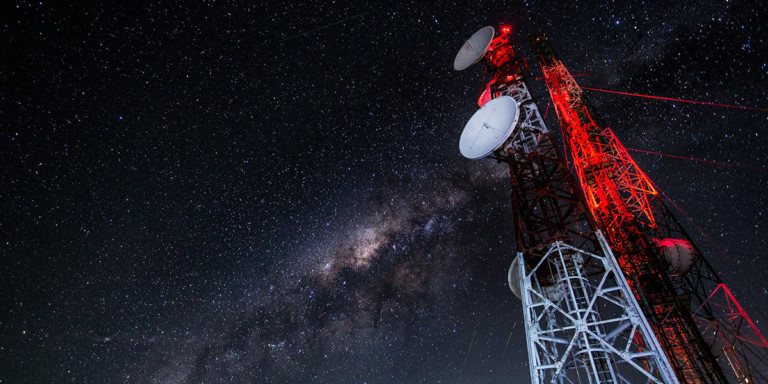Confronting Myths: Natural vs. Artificial EMF
Posted December 4, 2018 by David Schumann

Myth: We shouldn’t worry about wireless radiation because the universe is teeming with natural microwave radiation we are bombarded with constantly. Since we’ve always been exposed to ‘it,’ we don’t have to worry.
The same erroneous argument is applied to ionizing radiation, pointing to the naturally occurring sources in an effort to downplay the effects of anthropogenic nuclear radiation.
This argument is equally used to dismiss the concerns that wireless radiation affects our wellbeing. Since the universe is filled with cosmic microwave (and radio) radiation, the radiation emanating from our devices should be harmless by extension.
This couldn’t be farther from the truth and is a terribly misguided argument trying to equate two fundamentally different things with the word ‘microwave radiation.’ The artificially produced radiation that defines 21st century communication is vastly different than the cosmic background microwave radiation. Here is why, along with elucidation on this type of logical fallacy and related myths.
Cosmic Microwave Radiation
Almost all celestial bodies give off a wide spectrum of radiation, especially radio radiation that we can detect. The largest sources of radio radiation include pulsars, nebulae, quasars, and the massively active radio-galaxies. In these cases, the astronomical objects are the sources of radiation and we detect their presence by listening.
Background microwave radiation, however, is slightly different. It is pervasive across the universe and assumed to be a remnant from the Big Bang. Two scientists at Bell Labs, Arno Penzias and Robert Wilson, received the Nobel Prize in 1978 for their discovery of cosmic microwave radiation. They noticed it was coming from all directions and didn’t vary in intensity much. The source appeared to be the fiery explosion that formed the universe billions of years ago, but we’re still uncertain. This universal microwave radiation has been used more recently to try and understand the composition of the universe, leading to the theory that much of the cosmos is made of dark matter or dark energy. It’s presence is found everywhere and only in slightly varying intensities.

Natural vs. Artificial
The key difference is that cosmic microwave radiation is ‘noise.’ That is what the scientists discovered, a low-level static noise coming from all directions. The radiation that comes to us from cosmic sources like this is defined by mutually independent fields (photons) with different frequencies, phases, and polarizations. Just like the visible light from our sun, each photon of energy that arrives is independent, with a unique electric and magnetic field, but out of sync with all the rest. Together, they have no macroscopic electric or magnetic fields. They act alone. Their effects do not sum. This is why it is referred to as noise. Artificial electromagnetic radiation is completely different – here the signal coherency is everything.
For wireless devices transmitting microwave radiation, there is one basic frequency – called the carrier wave – that transmits the information. For example, a common Wi-Fi frequency is 2.4GHz (2.4 billion Hertz, or cycles per second). It is produced by running an oscillating current through the antenna. The radiation produced from this is not independent, rather all the photons are in sync, with the same polarization and phase. It is organized. The individual photons act together, called constructive interference, and an electromagnetic field is established.
Natural sources of radiation don’t summate, their fields interfere non-constructively or even destructively, producing a net field strength of zero. This means that the cosmic microwave radiation does not produce electromagnetic fields. Each individual photon from the radiation still produces an individual EM field, per Maxwell’s equations, but macroscopically it amounts to nothing. The peaks and troughs of the waves do not align, and coming from all directions, their vectors do not sum either making their net electromagnetic potential nothing. The suns rays still provide warmth and make all life possible, but without producing local electromagnetic fields (the sun itself produces a very large magnetic field, but not the individual rays of solar energy). The same is the case for cosmic microwave radiation – we can detect the noise from it, but it produces no net field. It is the electromagnetic field that is responsible for the detrimental health effects in our bodies.
Artificial sources of microwave radiation produce measurable field strengths by definition, or they would have no purpose. The EM field strengths produced depend on how much current is pushed through the transmitting antennas. All antennas produce measurable electric and magnetic fields, the strength of which is reduced typically by the square of the distance. These fields produce voltage differences, induce currents, and permeate every cell of our body with macroscopic and biologically active electric and magnetic fields. Cosmic microwave radiation does not. This is the difference. The only thing they have in common is the frequencies are in the microwave band, but this fact has little relevance when discussing their health impacts. The EM field strengths produced in our bodies is all that matters.
The Deeper Fallacy
What traps the mind here is the word. The science of radiation and health is littered with arguments constructed around words that represent broad categories of a wide-range of different phenomenon. In this case, the word ‘microwave radiation’ is used to imply equivalence when the actual frequencies, phases, polarizations, field strengths, and other nuances of the radiation are as different as they could possibly be. It is the same ridiculousness that has people comparing radioactive cesium ravaging your cells from the inside to the bath of cosmic radiation all life evolved under. It’s a classic marketing trick – trying to equate two things that are not equitable so we buy. In this case, they want us to buy the lie that artificial, wireless radiation is harmless. There are far more important factors that determine how radiation will affect our physiology.
Another confusion is based around ‘ionizing’ versus ‘non-ionizing’ radiation. The basic physics lesson is ‘ionizing’ radiation is dangerous because a single photon of it has enough energy to strip electrons from their atomic orbits, thereby breaking molecules, creating free-radicals, and damaging DNA. On the electromagnetic spectrum, frequencies higher than UV-B are considered ionizing, including UV-C, X-rays and gamma-rays. There are also energetic particles of mass (alpha and beta particles) that are ionizing.
Because of this fact, people take the position that ‘non-ionizing’ radiation is harmless because it doesn’t have the same ability to tear apart molecules, but this is foolish. A single photon rarely acts alone and a variety of damaging reactions can occur without directly ripping electrons off. The distinction has no real basis in determining the physiological impact of EM radiation, yet is often used to do so.
The UV light we are exposed to on terra firma is not ‘ionizing’ either, but still causes cancer. Likewise, light produces darkening of the skin and chemical changes that result in the production of a vital nutrient – vitamin D. Even in much lower frequencies, radio and microwave radiation can cause severe burns and death depending on the power. There are a number of ‘non-lethal’ weapon systems that use non-ionizing radiation to deter, torture, or incapacitate people. There are limited standards on wireless devices today because it is well understood that non-ionizing radiation has potentially detrimental biological effects. One of the most basic health effects from cellular radiation is the creation of free-radicals and the depletion antioxidants. This has been proven. This is the same physiological impact that ‘ionizing’ radiation has too, but the mechanism is different – the stimulation of free-radical chemistry.
By categorizing and using words to describe reality, we often lose sight of the actual thing. It would be like taking the musical scale and dividing it into two bands. We’ll call everything above middle C ‘x’ and everything below it, ‘non-x.’ Specific frequencies matter. Nuance matters. We are composed of specific frequencies and therefore the harmony we experience is dependent on the context of our own within those of our environment.
For wireless radiation, the type of tissue and specific frequencies are critical because there are resonances, and certain effects that are hard to distinguish. As in music, there are harmonious and disharmonious combinations of frequencies. Everyone can recognize various notes that do not belong together. We are the same. Some frequencies heal and others degrade. But it goes deeply beyond even the specific frequencies, to how we actually play them – the modulation, volume, tempo, interference with other notes, duration, our own make-up, and so much more is what determines physiological impacts.
Some EM radiation promotes the growth of harmful bacteria in our bodies. Others produce tension, disruptions, disease, and general discordancy in our bodies. The range of health impacts associated with microwave radiation in the frequencies used for communication is wide. There are promising frequencies that have been shown to promote tissue regeneration, well-being, relaxation, and healing. Not all EMF radiation is good or bad. It’s a nuanced discussion, but the evidence to date shows clearly that the frequencies and fields produced by wireless devices – especially pulsed signals and phased array sources – are highly determinantal to our health.
The engineers and scientists developing the technology are like beginners, banging loudly on the instruments without any real sense of their effects on the audience. They are playing and congratulating themselves while all of our cellular intelligence that can actually listen is recoiling to the discordancy strongly. The industry uses words, logical fallacies, and bad science to hide from the reality that their products are harmful.
Little by little, we’ll straighten the logic and move towards a more integral understanding of radiation and health. A step closer is to break the grip of categories and words that hamper the discussion.
The little word is has its tragedies; it marries and identifies different things with the greatest innocence; and yet no two are ever identical, and if therein lies the charm of wedding them and calling them one, therein too lies the danger.
Comments ( 0 )